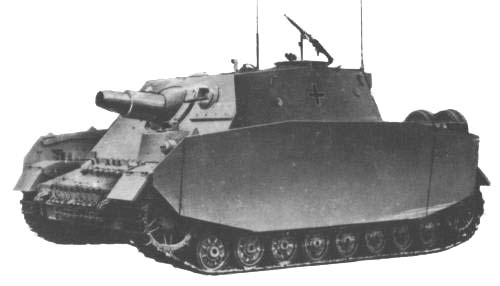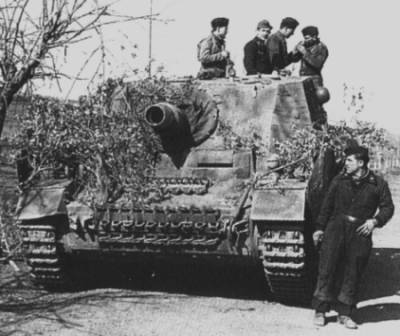|
|
|
Brummbar

German "Sturmpanzer IV"
Brummbar - Sd.Kfz. 166
As the war progressed, the Panzerwaffe found the need for heavily armored assault guns to supplement the armored forces in the artillery role. Although such vehicules were already existing (the Sturminfanteriegeschutz 33 and the Sturmhaubitze 42), they were considered more like temporary models, rather than true Sturmpanzers. Consequently, in early 1942, Alkett was ordered to produce a new Sturmpanzer with Krupp's cooperation. Alkett was in charge of designing the armor superstructure mounting a 150mm assault/attack howitzer, which was to be placed on a regular Panzerkamfwagen IV chassis modified by Krupp.
The plans of the Sturmpanzer IV ( Brummbar ) were presented to Adolf Hitler by Speer during a conference on October 14, 1942. A first production of 60 vehicules was ordered to be completed by spring 1943. The Brummbar was to use the Panzerkamfwagen IV chassis and the 150mm StuH 43 L/12 gun (developed from the sIG 33 by Skoda). Some prototypes were to be equipped with a 210mm mortar, but this project was quickly abandoned. In February 1943, a first wooden prototype was delivered by Skoda. The first series of 60 units was completed in May 1943 at the Army Depot in Vienna, in cooperation with Saurerwerke. They were built on new Panzerkamfwagen IV chassis (8 Ausf E and 52 Ausf G), provided by Nibelungenwerke. After extensive tests and many demands from the frontline units, full production started in November 1943. In the meantime, some modifications were made to the initial plans to improve the quality of the design.
Early Sturmpanzer IV's suffered from a weight problem, since the recoil and weight (1850kg) of the 150mm StuH 43 L/12 proved to be too heavy for the Panzerkamfwagen IV chassis. Consequently, the vehicles were prone to transmission problems and were underpowered, resulting in high fuel consumption. They were also easy targets for tank-killer squads since they lacked a machine gun in the front hull. Most of the 60 initial Brummbars were lost during the vicious fighting for the Kursk salient and later during the battles for Karkov.
In October 1943, it was decided to modify the superstructure and the gun to lower overall weight. Late-production models received a lighter version of the gun, designated 150mm StuH 43/1 L/12. A ball-mounted MG34 was installed in the front plate of the superstructure, while an anti-aircraft gun was fitted on the top. The height of the vehicule was reduced by changing the gun collar and the entire layout of the upper part of the superstructure. The commander received a new cupola adapted from the Stug III Ausf G assault gun. Finally, the Brummbar was equipped with Schurzen and was commonly covered with Zimmerit anti-magnetic paste. These vehicles from the last series didn't have any of the problems of their predecessors and proved to be effective and important weapons to the Panzerwaffe.The only problem that remained unsolved during the war was the limited storage space in the superstructure. Only 38 150mm rounds were carried, making the operations of the 5-man crew difficult due to the lack of space. Ammunition weight varied from 25kg for anti-tank rounds to 38kg for high explosive. The Sturmpanzer IV Brummbar was designed as a close-range direct-fire weapon to be used against dug-in infantry positions, buildings and almost any kind of stronghold. They were also used as support vehicles for panzergrenadier and infantry units.
From March 1943 to March 1945, 306 Brummbars were produced . They equipped 4 Sturmpanzerabteilungs and they saw action on all theaters of operations : from the open steppes of Russia to the dense bocage of Normandy and from the defense of the Ruhr to the last desperate battles throughout Hungary and Czechoslovakia.
By Pz_Tobruk
Crew: 5 (commander, gunner, 2 loaders, and driver)
Weight: 28.0 tons
Dimensions: 5.93 x 2.88 x 2.52
Armor (max): 50 - 100 mm
Range: 130 km
Speed (max): 24.0 km/hr
Main gun: 150mm L/ 12
No. Produced: 306

